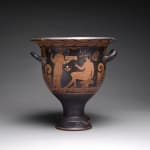Apulian Red-Figure Bell Krater, 400 BCE - 300 BCE
Terracotta
height 27.3 cm
height 10 3/4 in
height 10 3/4 in
DA.677
Further images
An essential vessel for anyone wishing to partake in the Bacchic pastime of wine-drinking, this wide-mouthed bell krater was specifically designed for holding large quantities of liquid; as it was...
An essential vessel for anyone wishing to partake in the Bacchic pastime of wine-drinking, this wide-mouthed bell krater was specifically designed for holding large quantities of liquid; as it was considered barbaric for wine to be drunk neat (and a privilege only enjoyed by Bacchus/Dionysus and his entourage who could handle such a level of intoxication) wine would be mixed with water, usually 1 part to 3. As such, craters provided an ideal large surface area for decoration, and as wine was of utmost importance to the Symposium, kraters would usually take centre place, and as such, the decoration of such vessels were geared towards such gatherings and attempted to provide subject matter for philosophical debate, or more usually, for titillation.
The obverse of this krater shows a nude seated male, his cloak being used as a cushion upon the rough rock upon which he sits. In his left hand he holds a thyrsus, and in his right a wreath. As such, taking into account this iconography, as well as being on a krater, it could be assumed that this figure is that of Dionysus. Stood before him is a woman, her high status indicated by her dress, as well as her jewellery, the details picked out in white paint. Her hair is fashionably worn, and she holds a mirror in her right hand to emphasise her femininity. What she holds in her left hand is more interesting. It appears to be some kind of box, and as it is being held before the male seated figure, it could be that its contents are intended for him. As is typical with these vessels, the reverse tends to be decorated with a more sombre tone, allowing the krater to provide two topics of conversation. Here there are two men facing each other. There are no attributes other than their cloaks which are wrapped around them, leaving only their feet visible. This is suggestive of both figures being deceased, but their roles in life are unknown due to the lack of any other symbols. The rest of the vessel is simply decorated to allow as much focus on the figural scenes as possible. Around the lower rim is a band of vines, and the platform for the figures is provided by a Vitruvian scroll. So as not to leave too much empty space, decorative palmettes are placed between the figures.
The obverse of this krater shows a nude seated male, his cloak being used as a cushion upon the rough rock upon which he sits. In his left hand he holds a thyrsus, and in his right a wreath. As such, taking into account this iconography, as well as being on a krater, it could be assumed that this figure is that of Dionysus. Stood before him is a woman, her high status indicated by her dress, as well as her jewellery, the details picked out in white paint. Her hair is fashionably worn, and she holds a mirror in her right hand to emphasise her femininity. What she holds in her left hand is more interesting. It appears to be some kind of box, and as it is being held before the male seated figure, it could be that its contents are intended for him. As is typical with these vessels, the reverse tends to be decorated with a more sombre tone, allowing the krater to provide two topics of conversation. Here there are two men facing each other. There are no attributes other than their cloaks which are wrapped around them, leaving only their feet visible. This is suggestive of both figures being deceased, but their roles in life are unknown due to the lack of any other symbols. The rest of the vessel is simply decorated to allow as much focus on the figural scenes as possible. Around the lower rim is a band of vines, and the platform for the figures is provided by a Vitruvian scroll. So as not to leave too much empty space, decorative palmettes are placed between the figures.









